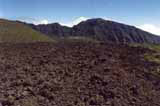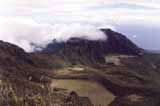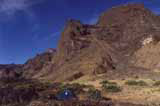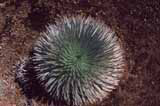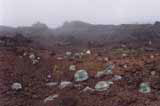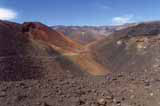
Haleakala National Park separeted from Hawaii Volcanoes National Park on 1st July 1961. Today park contains a crater 12 kilometers long and 4 kilometers wide. This crater was made by arosions of originaly circa 4 000m high volcano. No one knows when Haleakala last erupted, but volcano almost for sure will erupt again in next 100 or 200 years.
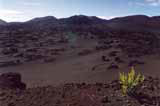 Combination of water, wind and changes of temperature created two big valleys - Ke'anae and Kaupö. As valleys were deeper and deeper in the end they had united and created one bigger crater s we can see nowadays. The highest point has 3 307m and in winter season can be covered by snow. Average altitude crater's bottom is 2 211m.
Combination of water, wind and changes of temperature created two big valleys - Ke'anae and Kaupö. As valleys were deeper and deeper in the end they had united and created one bigger crater s we can see nowadays. The highest point has 3 307m and in winter season can be covered by snow. Average altitude crater's bottom is 2 211m.
During life time the volcano several times aweaked and it's eruptions were even stronger then when volcano was born. In the crater's bottom are scenic volcanic cones. Both valleys that created the crater were partly filled up by black lava. Lava fileds are diferent age and in diverse shape. Aspecialy in windward slopes of Haleakala is rain forest. Anual rainfall ranges from 300 to 1 000mm or even more. The forest canopy is dominated by õhi'a tree in the upper elevations. With lower elevation start canopy, Diverse vegetation - smaller tree, ferns, shrubs and herbs - grows in the understory. Western part is more colorful and often gives feeling that you are on the moon.
Haleakala crater is usually surrounded by clouds and fog in mornings. Crater's walls keep them out site. but with warmer temperature in afternoons clouds especially at Paliku and Holua get over walls into crater. Weather forecast is difficult because it's instability. Days can be scorches and the nights cold as frost.
In these specific climatic conditions were born endemic plants like silversword. Hawaiians say that ti is the color of moonlight. It takes silversword 40 to 50 years to mature, it sends up in summer a magnificent flower stalk that can be almost three meters high and hundreds of buds open into brilliant reddish-purple blossoms. After just a few weeks of glory, the flowers crumple and the plant dies.
The most common access into the crater is by "Sliding Sands" track that starts at visitor center.
Campsites- in crater itself are three places where you can stay for night. At Paliku, Holua and Kapalaoa are build huts. Because big popularity and application reservations are by lottery and application has to received two months in advance before first day of the month in which a reservation requested. Campsites Paliku and Holua are also for a tents. In each you can stay maximum three nights and permit issued at visitor center is for free. At all these places is water that has to be treated before drinking.
Out site of crater are others two camps. There you do not need any permit. I spent twice night at Holua, third night I spent at Paliku. There you can take unmaintained track to the top of crater's slope with overlook. Last day I went downhill along 11,5 kilometers long path to Kaupo Gap at southeastern island. Change elevation was 2 013m. At the end of track is a little shop. Liter of water cost $2. Traffic here is not heavy because a road here is unpaved. But it is the only road around the island so who does not want to go back the same way has to drive through. I was lucky and got a lift to other part od national park to Kipahulu.



